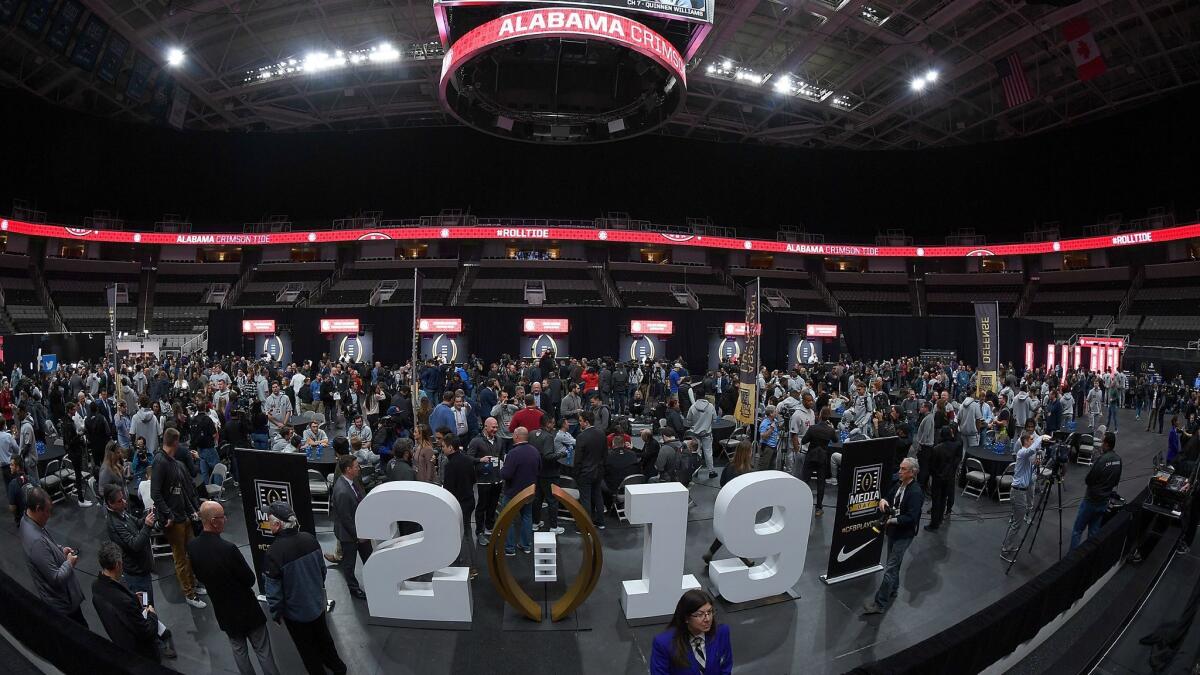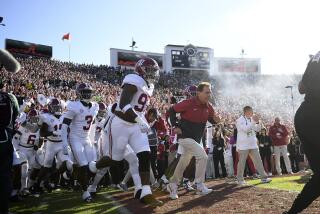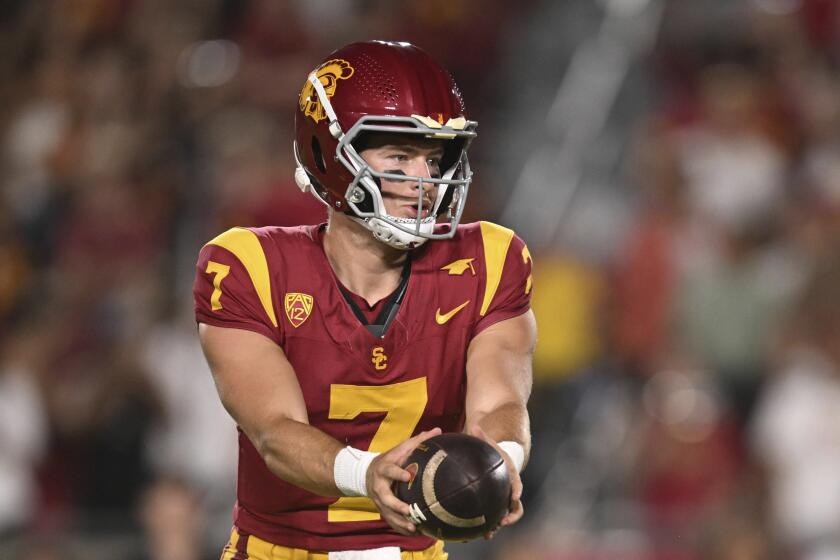Column: When the Tide rolls, these Alabama football players are just along for the ride

The arena floor that houses the CFP National Championship media day is arranged like the cliques in a high school cafeteria.
The stars and important coaches sit on stages. The rest of the offense, defense, special teams and coaching staff are given their groups of tables.
The big names attract all the cameras and microphones. The lesser names are surrounded by notebooks and tape recorders.
For Alabama on Saturday at SAP Center, there was one group that sat alone.
Their table was full, but empty. Their table was in the middle of the room, but completely invisible.
The eight young men sitting there play, but they don’t play. They are wearing soft white Alabama sweatsuits like everyone else, but they have organized themselves differently, not by position, but by status, by their shared hope in the clear reality of no hope.
“We don’t sit together by position, we sit together by who we are, because we have to have each other’s backs,’’ safety Andrew Heath said. “We’re the walk-ons.”
This is not the first story trumpeting the resilience of nonscholarship players in a star-driven college sports world. But considering Monday will be Alabama’s fourth consecutive CFP championship game — it’s third against Clemson — the role takes on new context.
Is there any walk-on more buried than those at a school experiencing a run of perhaps the greatest and deepest scholarship players in college football history?
“I hang around my coach, he never calls my name, then we run into the tunnel and wait for next week,’’ tight end Hayden Huckabee said.
Can any place offer these practice players less real-game hope that a dynasty where seemingly every regular is a five-star prospect?
“In situations where we’re up by a comfortable margin, the walk-ons flock to the coaches like, ‘We’re here, you don’t really need those five-star athletes right now, give us some reps,’ ’’ receiver Connor Adams said. “I’ve actually thought about asking the coach to put me in. My mom tries to get me to say it. But I just can’t say it.’’
Granted, Alabama has produced one of football’s greatest walk-on stories, and it could haunt them again Monday — Clemson coach Dabo Swinney began his college football career as a walk-on receiver with the Crimson Tide in 1989.
But the recruiting landscape has changed, the best players all flock to the best place, and in Tuscaloosa, the deck has never been more stacked against the guys at the end of the bench.
“When we play against the starters, it’s like first graders playing for fun against third graders who can kick their butts,’’ Heath said.
Whatever it is, the eight kids at this table are among the 30 or so listed Alabama walk-ons who pay the school’s cost of attendance — around $25,000 in-state and $43,000 out-of-state — for an unique opportunity to get steamrolled.
“I’m lucky that my parents are very loving,’’ junior tight end Giles Amos said.
The table is a happy group. The players say the team treats them well, like any other scholarship players except for those pesky tuition and housing bills. They eat in the same dining hall. They share the same locker room. They are awarded the same championship rings. They have access to the same equipment and medical care. While they look like regular students compared to the giant Alabama stars, they say they don’t feel any different.
But, they admit, it can be hard.
Some were listed on Saturday’s media day roster. Others were embarrassingly not.
“I’ve got to be on there,’’ said Heath, poring over my wrinkled handout with a laugh. “No. I’m not. Man, that’s just rude.’’
Some wonder whether legendary coach Nick Saban knows who they are. Others are pretty sure he does not.
“Yeah, we’ve never met, and he probably doesn’t even know who I am,’’ said Huckabee, who is also not on the roster for media day.
Some think they will eventually get into a game. Most accept the fact that they will not. They don’t deal in Rudy. They deal in reality.
”I’m looking forward for a chance to play one day … but I probably won’t,’’ Heath said. “I think they’ll call my number if a lot of important people get hurt, and I get a lot better.’’
So they don’t play, but they suit up, so they get all the social benefits of being a player, right? Well, sort of.
“When I walk around with my football backpack, people realize I’m with the team,’’ Heath said. “But they don’t think I’m a player, they think I’m an equipment manager.’’
They arrived here from all different places, with all different circumstances, the only common thread being that some folks thought they were crazy.
Taylor Wilson, a former Santa Ana Mater Dei defensive tackle, didn’t play his senior season because of a knee injury and was not highly recruited, so he said coach Bruce Rollinson made a phone call and helped him land with the Crimson Tide as “preferred” walk-on. Heath, meanwhile, actually joined the team after an open tryout during the winter of his freshman year. Yes, the greatest college football program of our generation actually holds open tryouts.
“I wasn’t doing anything but going to class, I was depressed not to be involved in anything, so I said, hey, why not go out for football?’’ Heath said. “My freshman year I’m in the student section, now I’m on the sideline, that’s quite the upgrade.’’
The upgrade is evident on Saturday home games and playoff games, when the walk-ons run on to the field with the team, warm up in front of thousands, then storm the field afterward in celebration as their parents watch with pride.
“His dad watches the game, I watch my son,’’ said Susan Heath, Andrew’s mother, who makes the 90-mile drive from Pell City, Ala., to Tuscaloosa for the home games. “I can tell you exactly where he’s at, what he’s doing, the entire game. He’s running out of the tunnel. His hands are up and he’s cheering. I watch only him. I’m honored to do it.’’
The walk-on agree that the real honor, while not monetary, is rich with a sense of belonging to something special.
“Even when it looks like you will never play, the reward is, you buy into the team, you buy out of yourself,’’ Amos said. “You put yourself into something that’s greater than you. There’s something good in that.’’
But if that moment does come? Amos is the only one of the eight walk-ons at this table who knows the feeling.
In his third year in the program, it finally happened this season in the final minutes of Alabama’s 56-14 victory over Louisiana Lafayette.
Somebody called his name. He ran onto the field. For four plays — he counted — the tight end threw the biggest blocks of his life.
“I’m like, all right, ‘Let’s do this,’’ he said.
Afterward, he stripped off his gloves and cleats and carried them back to his Tuscaloosa apartment, where today they sit, retired, on a shelf.
“One day, they’ll be there for my children,’’ he said. “They’ll know I was there.’’
The Alabama walk-ons are sometimes invisible, often overlooked, but always there and, for them, that is enough.
Get more of Bill Plaschke’s work and follow him on Twitter @BillPlaschke
More to Read
Get our high school sports newsletter
Prep Rally is devoted to the SoCal high school sports experience, bringing you scores, stories and a behind-the-scenes look at what makes prep sports so popular.
You may occasionally receive promotional content from the Los Angeles Times.







